Feature image © MonikaP — pixabay.com
Safari seekers will agree. The African wilderness and its wildlife can be utterly spellbinding.
If I have ever seen magic, it has been in Africa
– John Hemingway
There are few sights on the planet that will stir the soul of an adventurer quite like gazing into the eyes of a Maasai warrior in full finery.
These fearless, calm and courageous people have been captivating westerners for centuries.
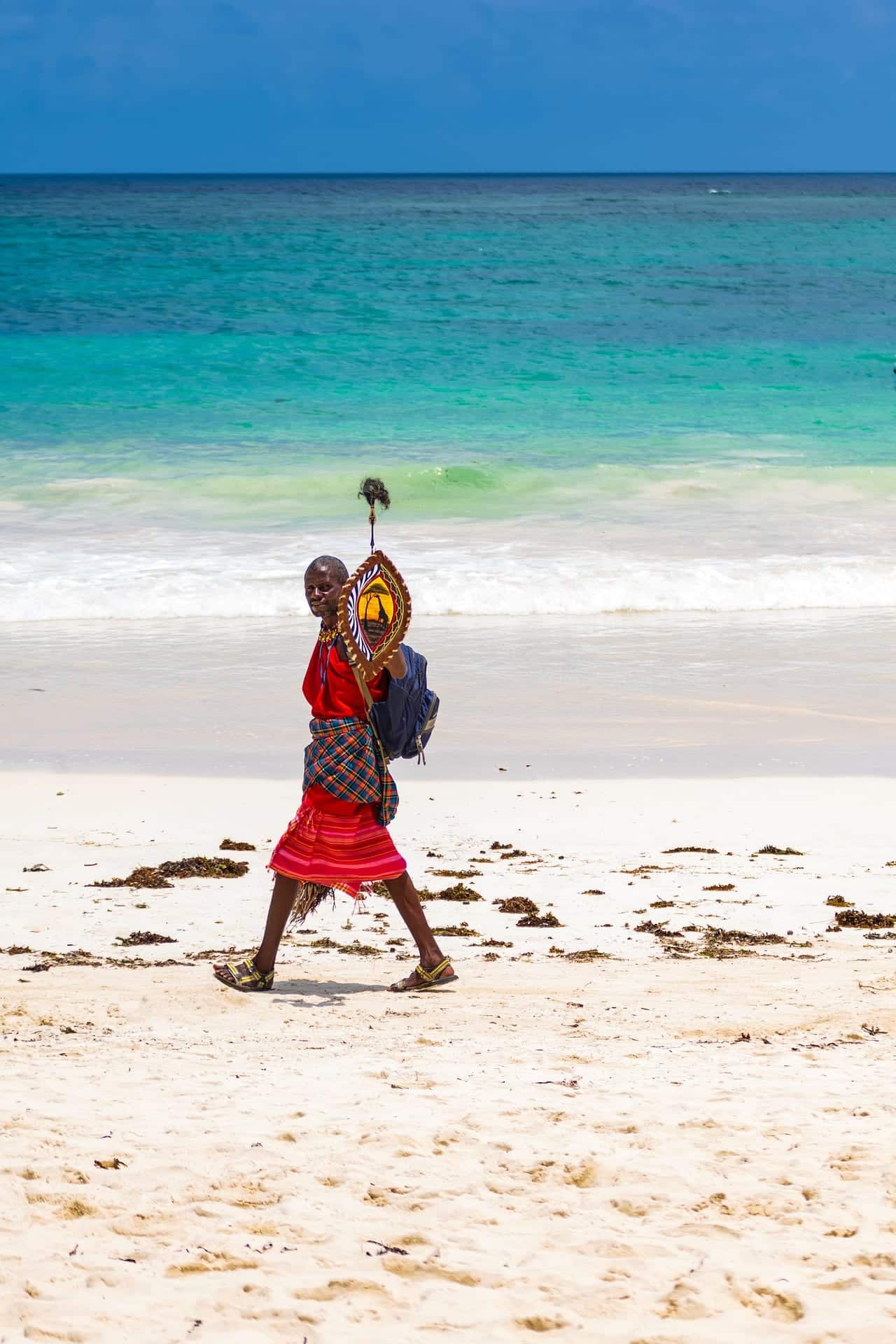
According to Karen Blixen:
A Maasai warrior is a fine sight. Those young men have, to the utmost extent, that particular form of intelligence which we call chic; daring and wildly fantastical as they seem, they are still unswervingly true to their own nature, and to an immanent ideal. Their style is not an assumed manner, nor an imitation of a foreign perfection; it has grown from the inside, and is an expression of the race and its history, and their weapons and finery are as much a part of their being as are a stag’s antlers.
But you already know that the Maasai people are extraordinary. And mere words can never capture the frisson of excitement, the vague promise of danger, the pure admiration one feels when you meet the Maasai tribe.
Instead, we will tell you their stories.

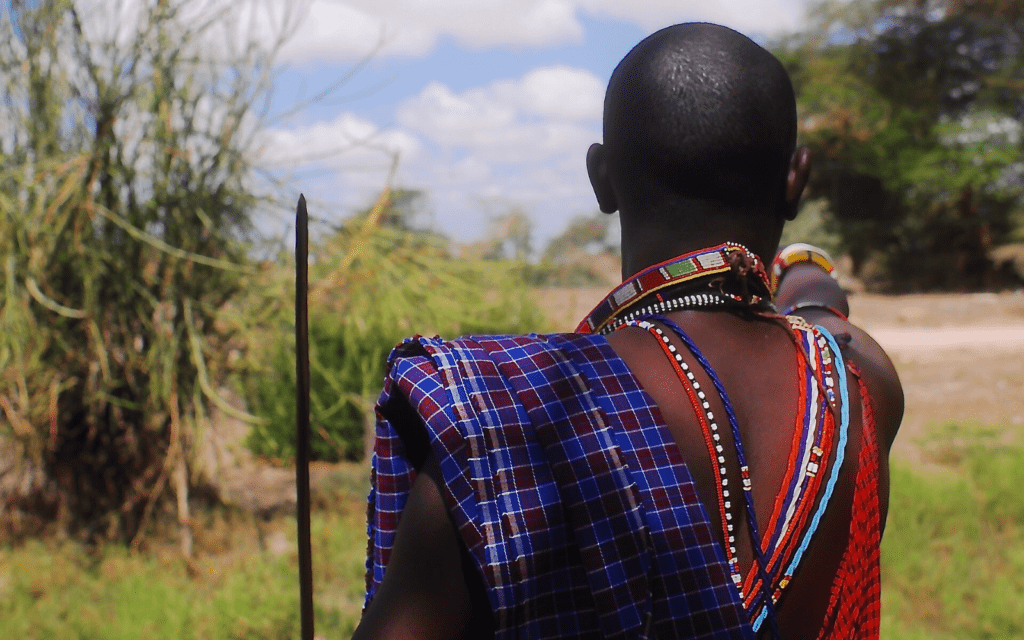
A Western History of the people who speak Maa
There are over fifty native tribes in Kenya.
It can be argued that the Maasai remains the most iconic. They occupied the most fertile lands when the European settlers arrived at the start of the 20th century and they continue to be uniquely proud of their traditions, stories, and lifestyle.
The incorrect use of the word Masai to refer to the Maasai is a remnant of British colonialist spelling. Masai means spotted, which is how the Maasai described their environment, dotted with trees, and so we call the Game Reserve the Masai Mara.
Maasai refers to people who speak Maa, a language consisting of 30 contrasting sounds that convey mood through tones.
Some of the elders living in rural areas still speak Maa exclusively but most of the Maasai people also speak Swahili and English.
To the Western eye, the Maasai community seems homogenous but there are actually 22 distinct geographic sectors or sub-tribes, known as nations and each has its own customs, appearance, leadership, and dialect. The population of this Nilotic tribe that can be found throughout most of Kenya and in northern Tanzania has shown promising growth in recent decades in spite of the governments of both countries backing programs to encourage modernization and an abandonment of the traditional semi-nomadic lifestyle.
15th Century
According to oral history, genetic analyses and linguistic study, the Maasai arrived in the Great Lakes region from the lower Nile valley and South Sudan around the 15th century.
The Maasai quickly gained a fierce reputation as warriors and cattle rustlers. Many of the ethnic groups in the region were displaced by incoming Maasai and some of the Southern Cushitic groups assimilated into Maasai society. At the same time, they adopted traditions from neighbors, like the age-set system of social organization, circumcision, and vocabulary. The Maasai were fiercely opposed to slavery and their respect for their environment extended to an aversion to eating game and birds.
19th Century
By the mid 19th Century the Maasai ruled almost all of the Great Rift Valley and from Mount Marsabit to Dodoma. Maasai raiders were feared for their spears and shields and they could accurately throw their orinka club across 70 paces.
Nilotic expansion was only forced into retreat by the Maasai Emutai of 1883 – 1902.
During this period contagious bovine pleuropneumonia, rinderpest, smallpox and drought (including no rain in 1897 and 1898) killed 90% of cattle, half of all wildlife and two-thirds of the Maasai. When the Austrian explorer Oscar Baumann arrived in the Ngorongoro crater in 1891 he described “women wasted to skeletons, warriors scarcely able to crawl on all fours, and apathetic languishing elders. Vultures,” he said followed the Maasai from on high, ”awaiting their certain victims.”
20th Century
As they are semi-nomadic and pastoral they require large tracts of lands for their cattle and goats and unfortunately, their spears were no match for the British guns and their lawyers, forced into British courts, lost their most valuable land to their colonizers in 1904. Then, in 1911 Laikipia was also signed over to the white settlers by signatories that did not represent all the members of the tribe and who could not understand the full consequences of the treaty.
The Maasai now had to make do with less fertile parts of Kenya and Tanzania.
Chances are good that you will know the land the Maasai lost through treaties with the British by name:
- They had to give up the fertile land between Mount Meru and Mount Kilimanjaro.
- And the fertile highlands near Ngorongoro.
- They also gave up what we now call Amboseli National Park, Nairobi National Park, the Masai Mara, Samburu National Reserve, Lake Nakuru National Park, Tsavo, Lake Manyara, the Ngorongoro Conservation Area, Tarangire and Serengeti National Park.
Of course, their struggles were not confined to the fall out of colonialism.
As their culture was a stubborn one they did not move with the times as easily as other tribes who found it easier to throw off their traditional ways.
21st Century
The Maasai aren’t interested in a sedentary lifestyle. They want to remain pastoralists.
The modern trend of growing populations meant even less land for the Maasai and their livestock. And as the Maasai is forced to carve out an ever restricted existence their livestock would also fall prey to lions and other predators, because the Maasai continue to share their home with Africa’s most iconic species in the 21st Century. They live amongst lions, elephants, leopards, giraffe and the zebra and wildebeest that migrate through their lands.
The Maasai also reign over forests that are carbon sinks, some of the most incredible reserves on earth and the freshwater that is of great economic importance to the rest of their countrymen.
Their unique position makes it incredibly important to have experts work with the tribe on a knowledge-sharing basis to create and implement holistic and comprehensive conservation, health and education programs. Interaction with the Maasai must serve the community as well as their surroundings.
The endeavor to maintain Masai Mara in a natural state, in balance with wildlife and to preserve the traditional Maasai way of living and their dignity is something that Rothschild Safaris support wholeheartedly.
Our safari partners are carefully chosen to ensure that the Maasai who want to retain their heritage can do so and that every visitor contributes to this dream.
Today there are an estimated one million Maasai living in Kenya and Tanzania.
(We can’t know the exact number as many clans refuse to be counted and many individuals have migrated to bigger cities.)

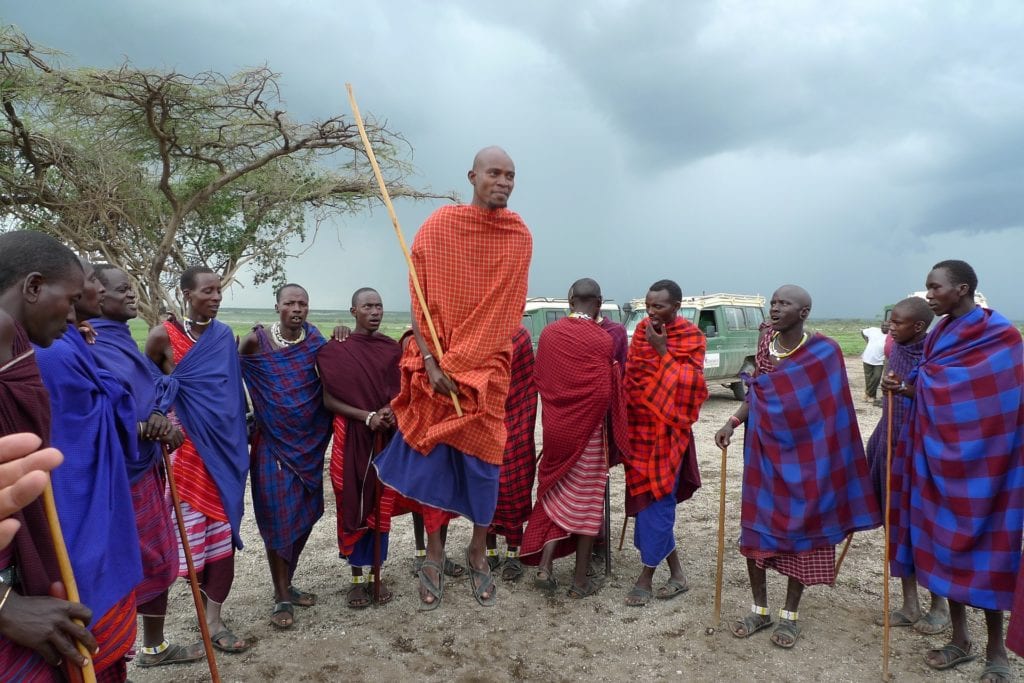
The Culture of the Maasai
The bright red robes of the Maasai set them visually apart. They might be the most recognizable tribe in all of Africa, but there is much more to the Maasai people than meets the eye.
Maasai Rules and Religion
The Red Cow and Black Cow are two pillars of Maasai society which is further divided into five clans. A strongly patriarchal society, the elderly men of the tribe will have the final decision about all matters according to a full body of oral law that covers most aspects of behavior. Capital punishment does not form any part of the traditional Maasai way and disputes are usually settled through payment in cattle.
Shamanistic healing, divination, prophecy and practical matters like politics, war, and the weather are all overseen by a ritual expert or oloiboni.
The Maasai are monotheistic and worship a single deity, Ngai (also Enkai or Engai) who has both a benevolent and a vengeful side. Ol Doinyo Lengai in northernmost Tanzania is considered the ‘Mountain of God’ by the Maasai. The lion is their totemic animal. A Maasai boy could only achieve warrior status once he had single-handedly killed a lion with his spear (this is, of course, outlawed in modern times and now lions are only hunted when they kill cattle.)
In modern times it is common for Maasai to identify as Christian or to follow Islam.

Maasai Birth and Death
Infant mortality used to be so high that the Maasai would only recognize and name a baby if it managed to reach the age of three months (three moons). This ceremony survives, but today Maasai women use clinics and hospitals during pregnancy and it is normal for most infants to survive.
Death is not marked in any way. Instead, bodies are left out, often covered in fat and blood from an ox to ensure that they would be eaten by opportunistic animals (it is unlucky for a corpse to be ignored by wildlife). Burial is considered harmful to the soil and has been reserved for particularly great chiefs.
Maasai Riches
Wealth is measured in cattle and children. A deficit of either will result in a man being considered poor. Around 50 heads of cattle is a respectable number to own. Luckily, according to their religion, the Maasai believe God gave them all the cattle on earth — which resulted in much cattle rustling to achieve the desired number of animals, as they believed they were simply reclaiming what was rightfully theirs. In modern times the practice of rustling is less common.

Maasai at Table
Maasai diet traditionally consists of raw meat, raw milk, and raw blood from their Zebu cattle with some vegetables and fruit when it is available. Early studies of the Maasai confirmed that they were mostly disease-free.
In the middle of the last century, a number of texts falsely influenced ecologists and policymakers to believe that the Maasai pastoralists were harming the savannah rangelands. All the Maasai were promptly removed from the Serengeti National Park and relegated to areas in and around the Ngorongoro Conservation Area.
Here, HIV spread, cattle died from disease and farms of other tribes encroached upon their available ranchlands. Soon, the Maasai were forced to cultivate maize and rely on crops like sorghum, rice, potatoes, and cabbage. Culturally the practice was viewed negatively by the Maasai and between 1975 and 1992 the NCA also banned the Maasai from growing food.
As their circumstances changed again the Maasai have moved towards including maize meal and sugar with butter.
Acacia nilotica stem or root is used as a drug to make Maasai warriors aggressive and fearless.
The Maasai continue to outperform westerners on cardiac, cholesterol and fitness tests.

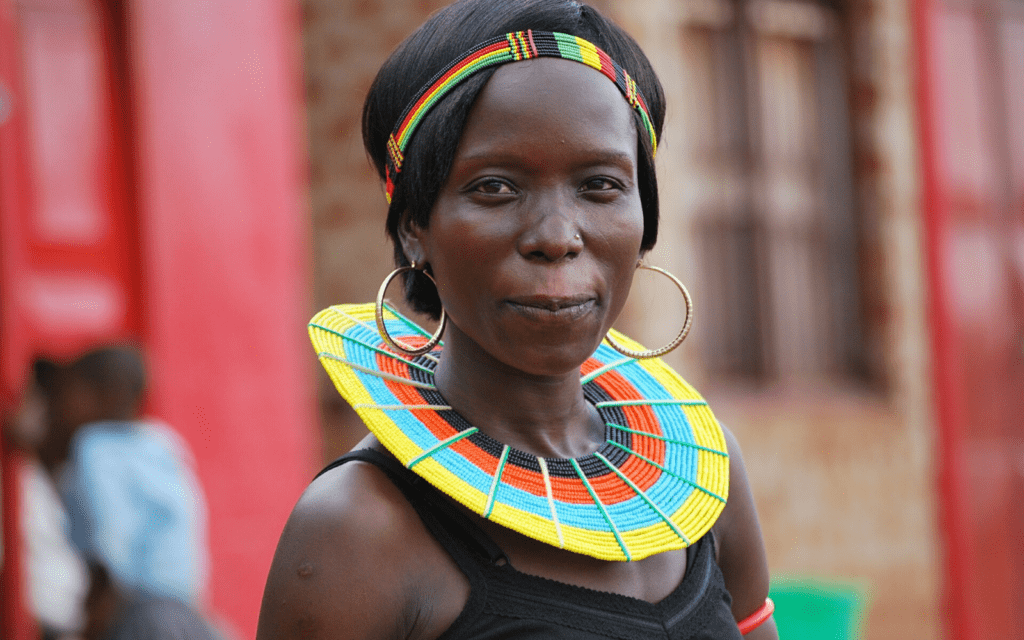
Maasai society
The Maasai society is organized around an age-set.
Every 15 years or so an individually named, new generation of Morans or Il-murran warriors is initiated. The age-set will involve boys who have reached puberty but was not part of the previous age-set.
Before they come of age, the boys mostly play with their friends (although ritual beatings to test courage and endurance may be doled out). For girls, life consists of chores that are taught by their mothers.
Graduating from boyhood to adulthood includes anesthetic-free circumcision as a rite of passage. It is important for a boy to endure his ceremony without any expression of pain. The operation is performed by the elders and in modern times greater care has been taken to ensure sterile conditions. Healing will take around three or four months and the boys wear black clothing for up to eight months.
Circumcision is only the beginning of a series of rites of passage culminating in the Eunoto or coming of age ceremony. As the new group graduates, the previous age-set become junior elders and the junior elders become senior elders.
The Kenyan and Tanzanian governments continue to encourage the Maasai to make permanent agricultural settlements and to stop isolating young men. Formal education and greater assimilation are also advocated.

Young women are required to undergo ritual circumcision before entering into arranged marriages at a very young age. Uncircumcised girls are not considered marriageable or worthy of a good bride price.
The act of female circumcision divides East Africa.
The practice is deeply ingrained and valued by the culture… but it is illegal in both Kenya and Tanzania.
Uncircumcised women, even highly educated members of parliament like Linah Kilimo may be considered immature.
The west and many women who have undergone circumcision regards it as female genital mutilation and criticize the practice vehemently.
In Maasai society, pregnant women are excused from chores and are subject to special rules.

The Maasai are traditionally polygynous with a woman marrying not just one man but his entire age-set. Men are expected to give up their bed for a visiting age-set guest although a woman can choose whether she will join the visitor. Children resulting from guest relations are considered the husband’s child. (This method will also be used when a man cannot father children.)
Because young Maasai are too busy protecting their village (and grooming their hair!) to marry there are often big age gaps between the elder men and young girls who marry them.
A wife who is grossly mistreated can choose to divorce her husband and move back in with her father.

The Maasai inherit their wealth from their fathers. Near-death, a Maasai elder will call his sons and distribute his cattle to them. All the brothers will give some of their wealth to the eldest brother to avoid the curse of Engooki which will seek out those who profit from their father’s death.
The fact that so many Maasai still live a traditional life in spite of a century of pressure from all sides not to is extraordinary. Some may even go to work in an urban environment, blending in with westerners quite seamlessly before they return to their homestead where they will don a shuka, cowhide sandals and disappear back into traditional community living.
It is a testament to their wish to remain true to their culture. And it is a privilege for us to support the Maasai and the projects that work to preserve their lifestyle through travel.
Maasai Music and Dance

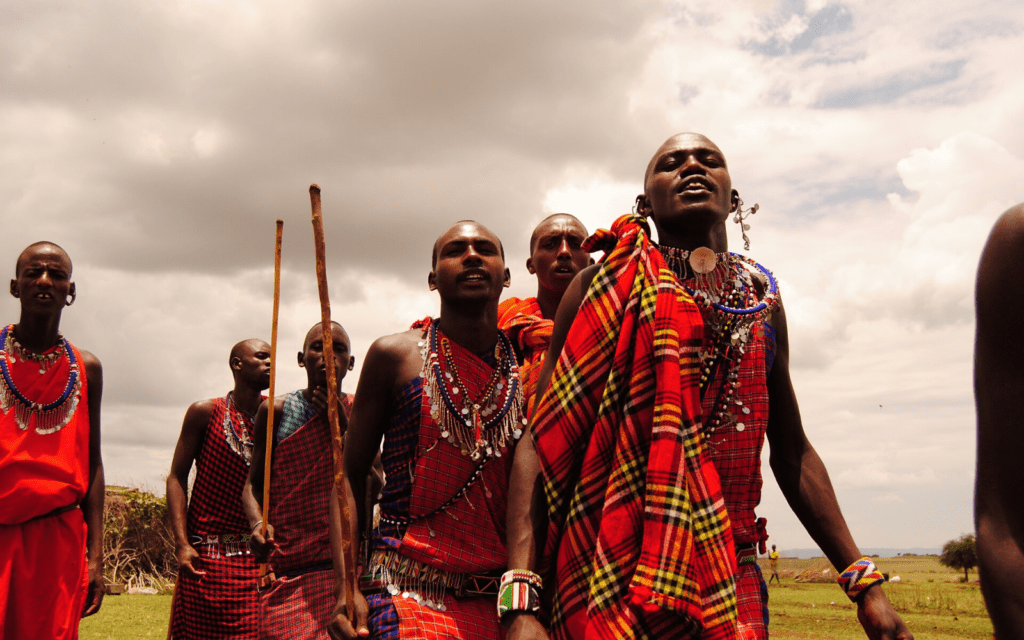
If you are ever lucky enough to spend any amount of time with the Maasai you will quickly learn that they will seek out any opportunity to sing and dance.
The Maasai songs are led by the person who knows the song best – known as the Olaranyani or song leader, they carry the melody.
Songs are based on call and response with specific neck movements accompanying the singing and breathing, resulting in polyphonic syncopation. Drone polyphony is also distinctive to the Maasai.
The horn of the Greater Kudu is used to summon morans to the Eunoto ceremony.
Song and dance play a large role in flirting and coming of age. Men will make sounds to mimic cattle calls, jumping high into the air to impress the women while the ladies will shake their necks and shoulders, displaying their jewelry by moving it back and forth.
Contemporary artists are incorporating traditional Maasai music into their Hip Hop or reggae performances.

Maasai Body Modification
Piercing the earlobes with thorns and using twigs, stones, elephant tusks, and empty film canisters to stretch the earlobes used to be very common amongst the Maasai.
There is a strong belief that the deciduous canine tooth buds of children can cause diarrhea, vomiting and febrile illness and the removal of these teeth at a very young age is frequently practised.

Maasai at Home
As a nomadic tribe the traditional Maasai home did not need to be a permanent construction.
The Maasai hut would be very small, usually only one or two rooms and so low that the tall Maasai would not be able to stand upright inside. Circular or loaf-shaped, the huts were traditionally built by the Maasai women with cow dung mixed with mud, sticks, grass and bare floors.
All the huts were then enclosed with a fence built by the men with thorn branches to keep humans and stock safe from wild animals.

Maasai Fashion
For the Maasai, clothing is closely associated with age and location. Red is a firm favorite and blue, black striped and checkered cloth are combined with animal skin, calf hides, and sheepskin. Simple cowhide sandals are worn. Modern sandals are also made from tire strips or plastic.
Men and women adorn themselves with wooden bracelets and the Maasai women are famous for the ornamental jewelry they bead and weave to articulate their identity and position.
Color is strongly connected to meaning.
White for peace (traditionally clay, shells, ivory or bone)
Blue for water (traditionally iron, charcoal, seeds, clay or horn)
Red for warriors, blood and bravery (traditionally seeds, woods, gourds, bone, ivory, copper or brass)
Today European glass beads, with a dense, opaque and smooth finish are preferred.

Common Maasai garments include:
- Shúkà – The Maa word for sheets traditionally worn wrapped around the body.
- Kanga – A Swahili term for a one-piece garment that is commonly worn.
- Kikoi – A striped sarong worn by Maasai near the coast
Maasai Coiffure
It is easy to see differences from afar but as we spend time with other cultures what we notice is always the underpinnings of our humanity. The Maasai, much like their western counterparts consider a hair cut as a shortcut to a fresh start!
Warriors are the only members of the community to wear their hair long. Locks are shaved off when the warriors become elders as they are required to wear short hair.
Babies who reach the age of three months or ‘moons’ have their heads shaved apart from a cockade running from the nape of their neck to their forehead to symbolize their state of grace. Mothers may also alter the pattern of the baby’s hair to honor previous pregnancies and births.
Boys have their heads shaved two days before circumcision. As the young warriors grow their hair they will spend a lot of time styling their hair… an activity that will continue until they become elders when their hair is once again shaved off.
A bride to be will also shave her head to prepare for marriage.

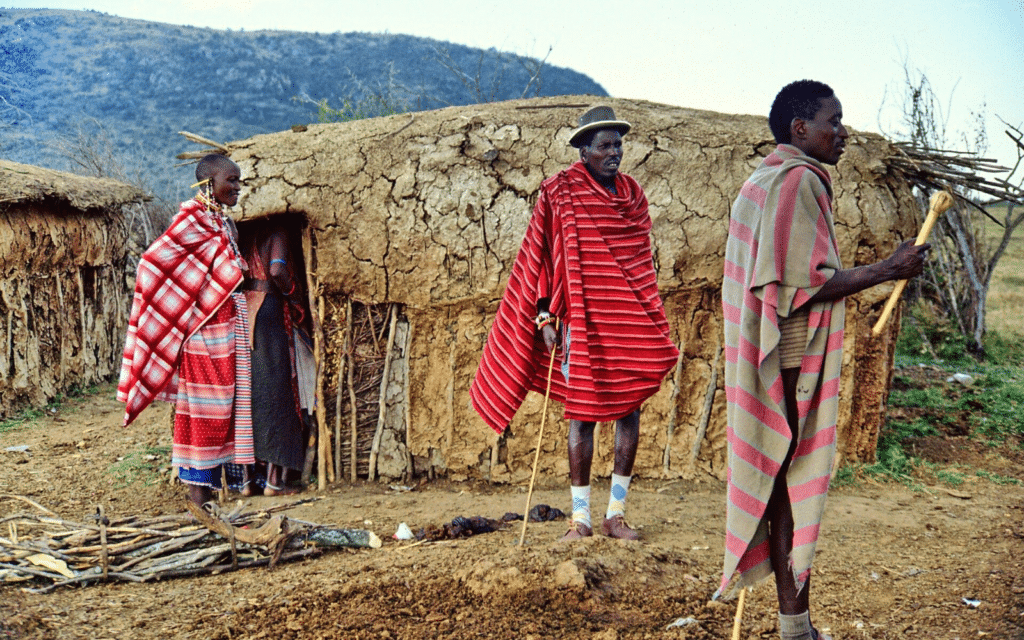
Modern Maasai
Individuals from Maasai tribes can be found in big cities around the world, engaged in modern jobs, businesses and government roles.

Click here for a great selection of books about the Maasai.


